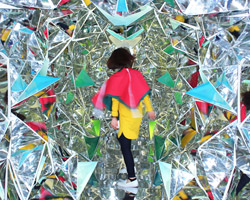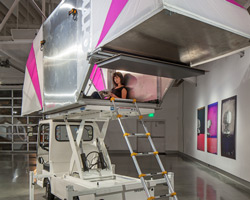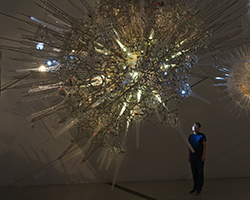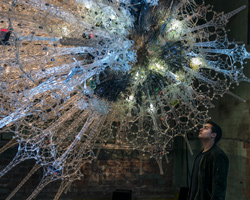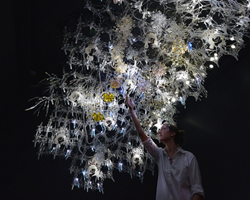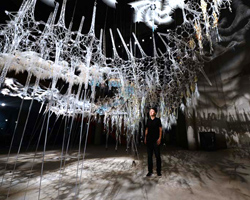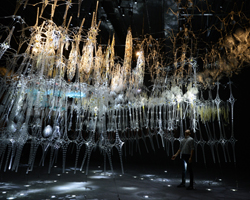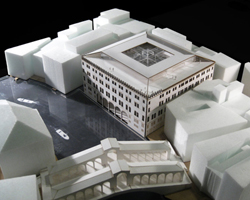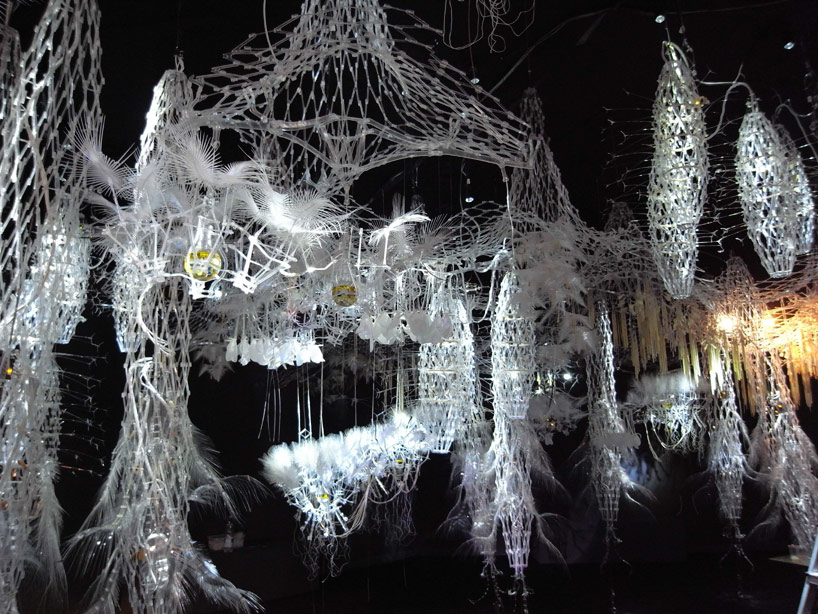
‘hylozoic ground‘, canada’s official national pavilion for this year’s la biennale di venezia, is an experimental piece of architecture that explores the qualities of contemporary wilderness. designed by canadian architect and sculptor philip beesley, the installation is constructed out of an intricate system of transparent acrylic meshwork links, covered with a network of interactive mechanical fronds, filters, and whiskers.
 image © designboom (also main image)
image © designboom (also main image)
the root of the project’s name, ‘hylozoism’, refers to the ancient belief that all matter has life. true to its source, the whole installation functions similarly to a giant lung, breathing in and out around its occupants. the interactive piece of architecture responds to human presence and movement by tens of thousands of lightweight digitally-fabricated components which are fitted with microprocessors and proximity sensors.
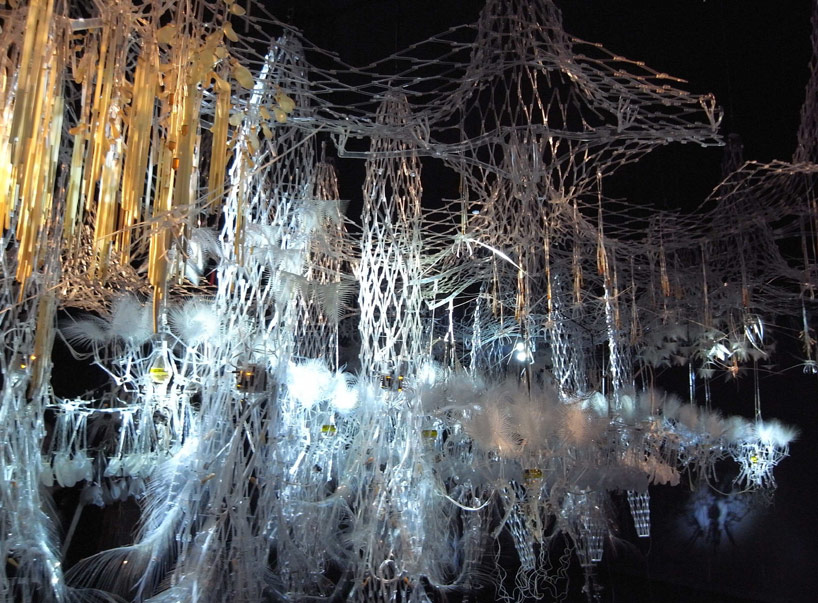 image © designboom
image © designboom
‘hylozoic soil’ explores how the built environment can affect humans on an emotional and poetic level, bridging the gap between the animate and the inanimate. the technologies used in the construction of the installation has the potential to be applied and translated to fields beyond the discipline of architecture such as geotextiles, material science, environmental engineering, robots, and biotechnology.
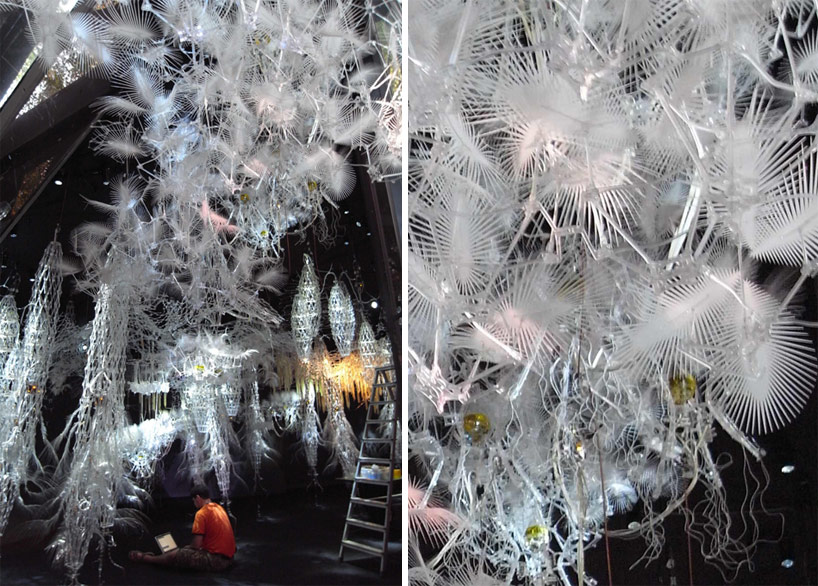 image © designboom
image © designboom
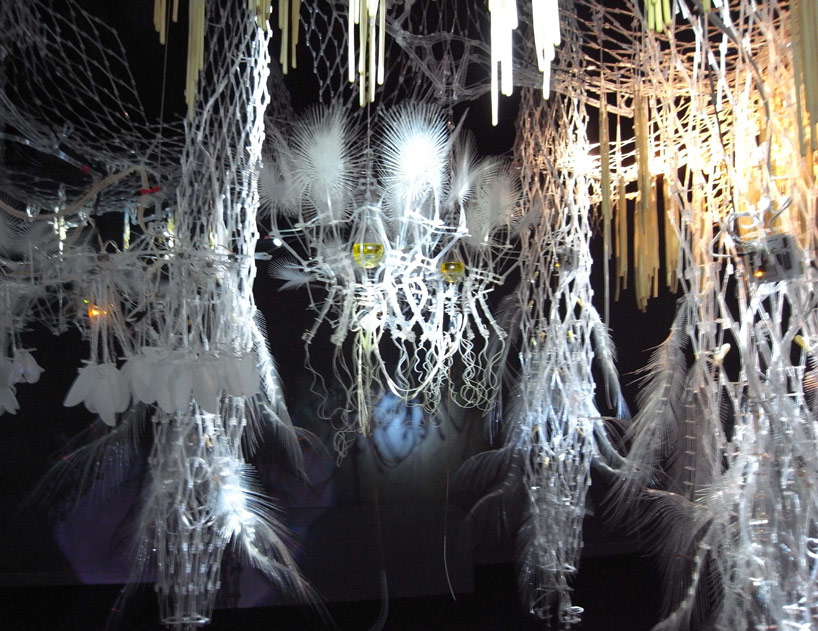 image © designboom
image © designboom
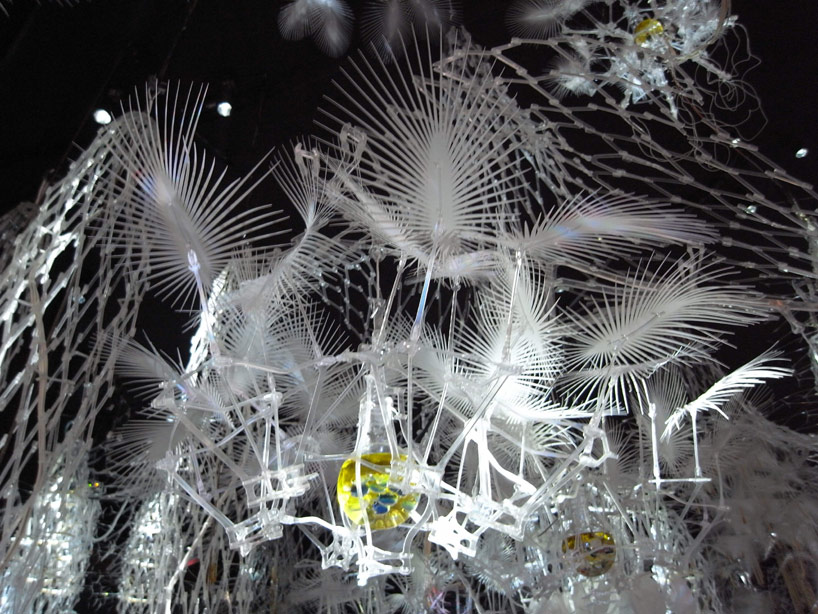 image © designboom
image © designboom
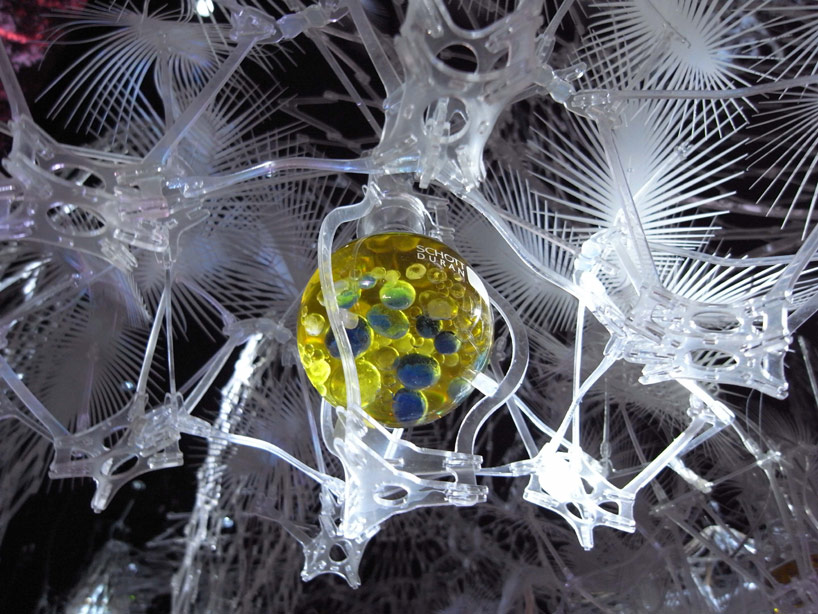 image © designboom
image © designboom
 image © designboom
image © designboom
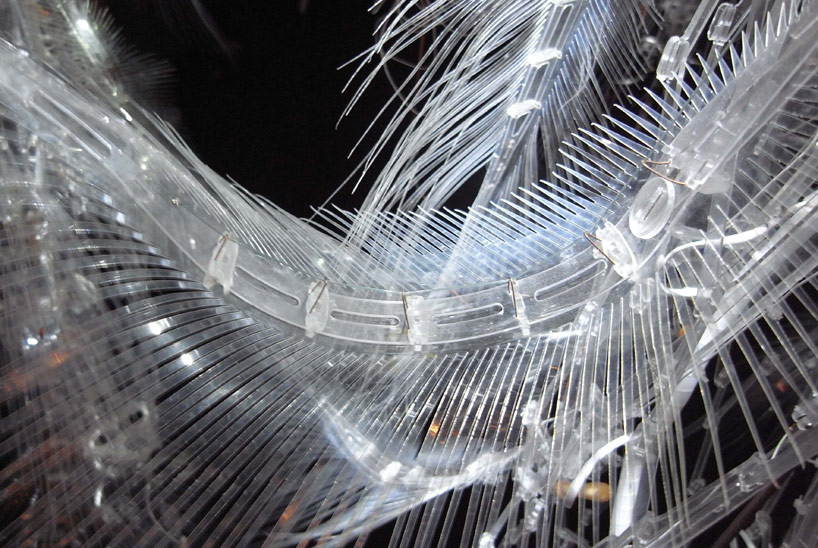 image © designboom
image © designboom
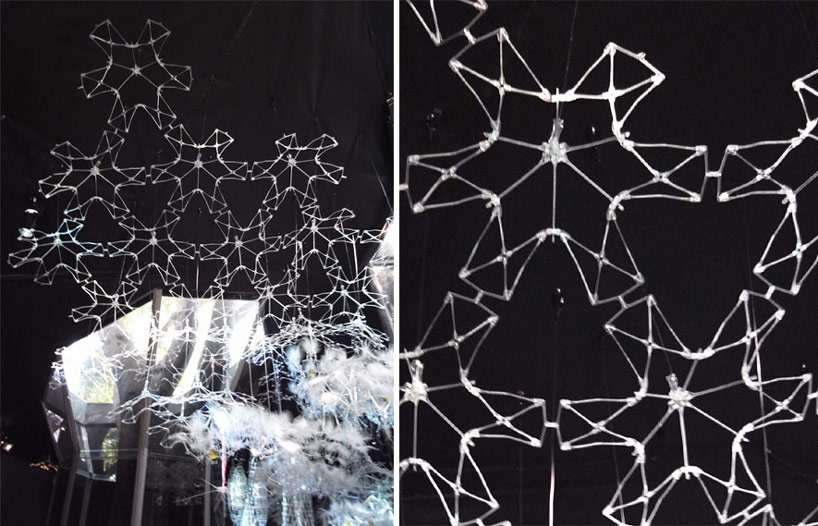 image © designboom
image © designboom
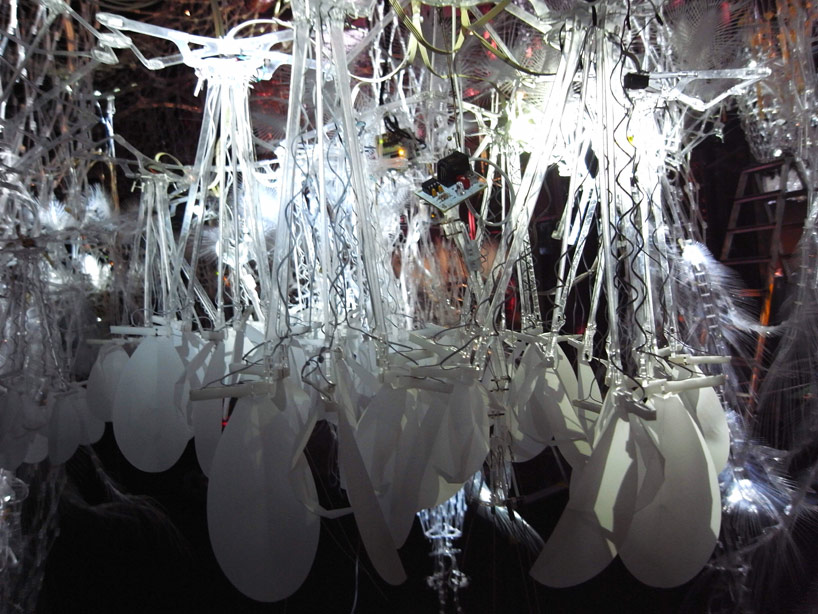 image © designboom
image © designboom
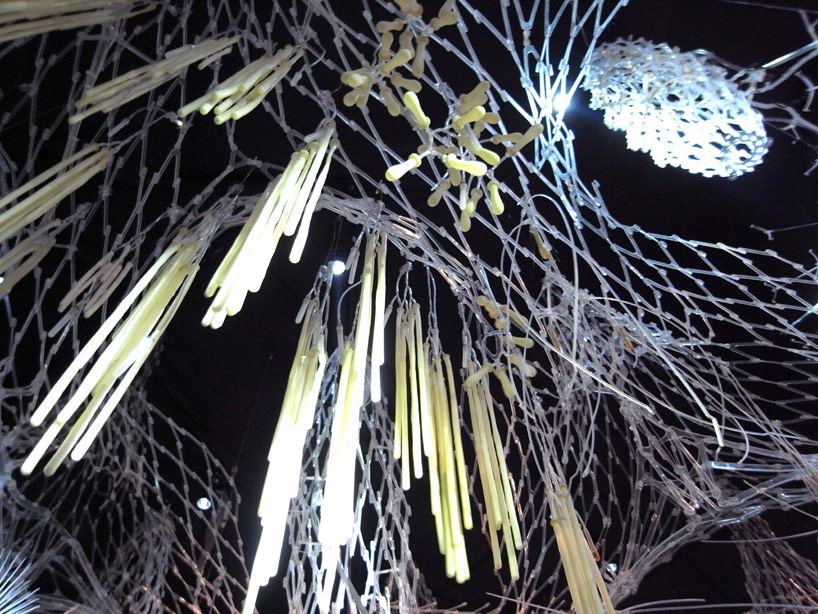 image © designboom
image © designboom
 image © designboom
image © designboom
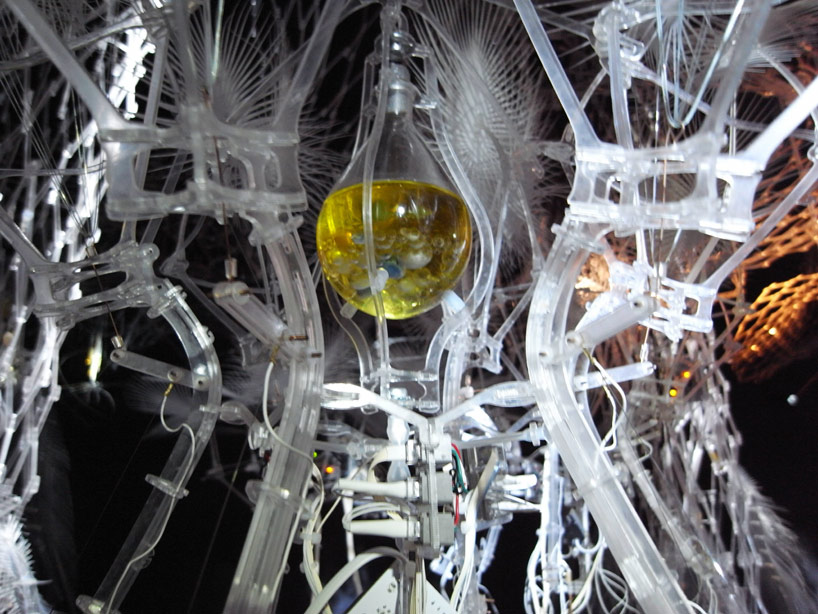 image © designboom
image © designboom
 image © designboom
image © designboom
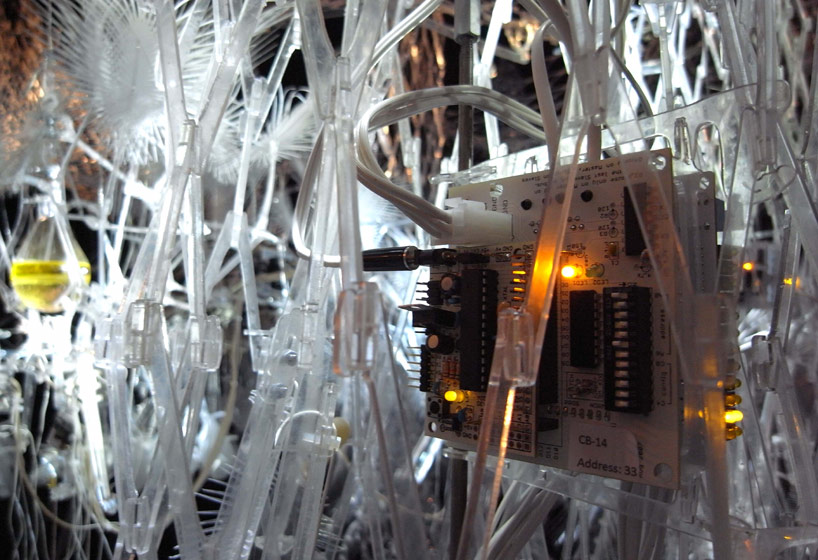 image © designboom
image © designboom
 image © designboom
image © designboom
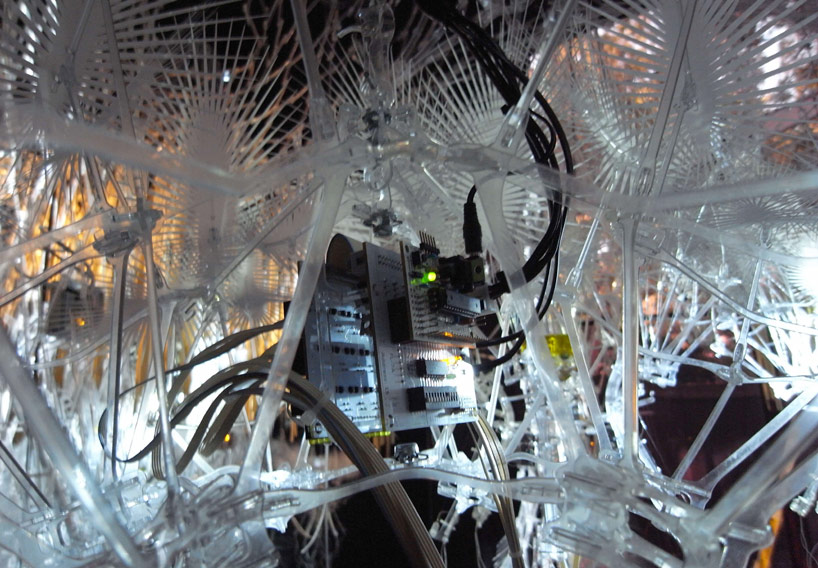 image © designboom
image © designboom
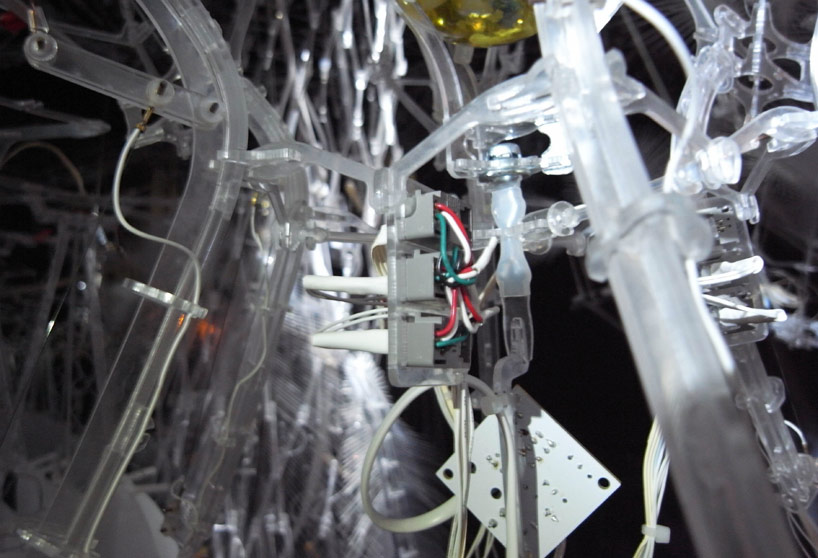 image © designboom
image © designboom
 weed detail image © pierre charron
weed detail image © pierre charron
 filter detail image © pierre charron
filter detail image © pierre charron
 (left) swallowing column detail (right) filter detail images © pierre charron
(left) swallowing column detail (right) filter detail images © pierre charron
 (left) breathing column (right) breathing column detail images © pierre charron
(left) breathing column (right) breathing column detail images © pierre charron
 filter layer protocells image © pierre charron
filter layer protocells image © pierre charron
 reflexive membranes
reflexive membranes
 cloud layer
cloud layer
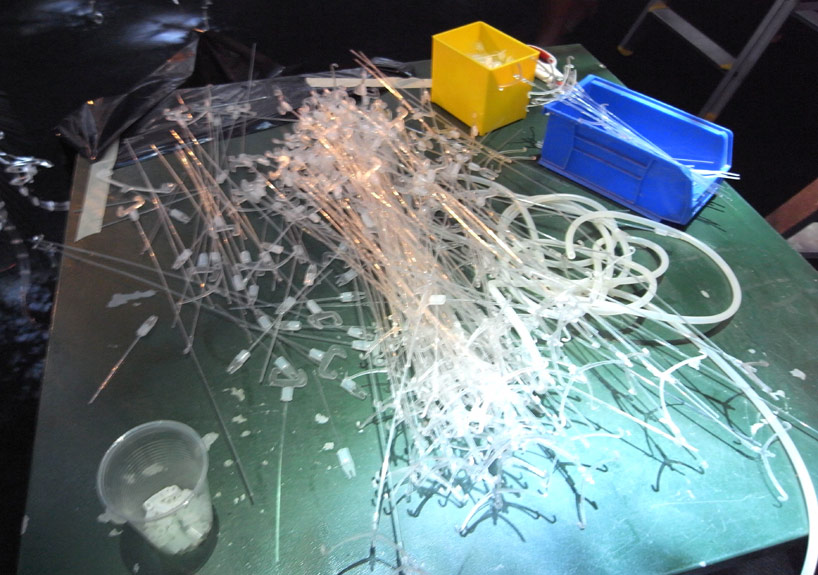 image © designboom
image © designboom
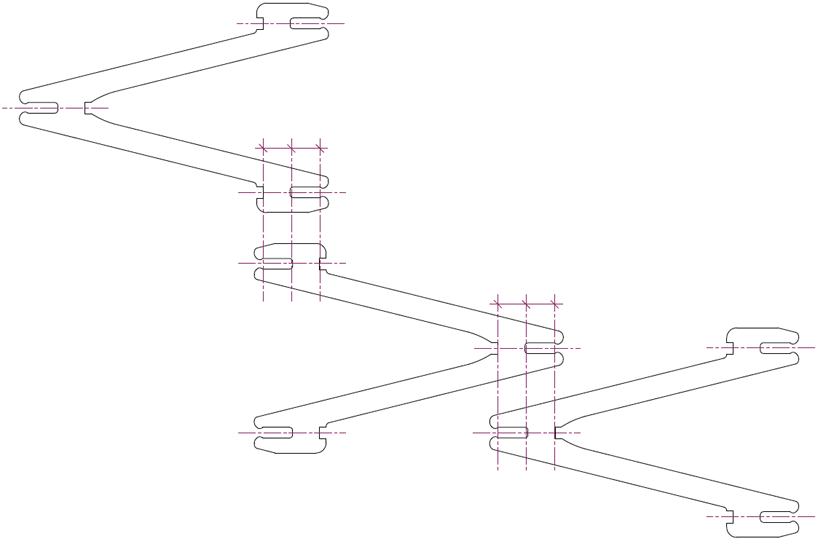 all drawings courtesy philip beesley architect
all drawings courtesy philip beesley architect
 filter cluster plan
filter cluster plan
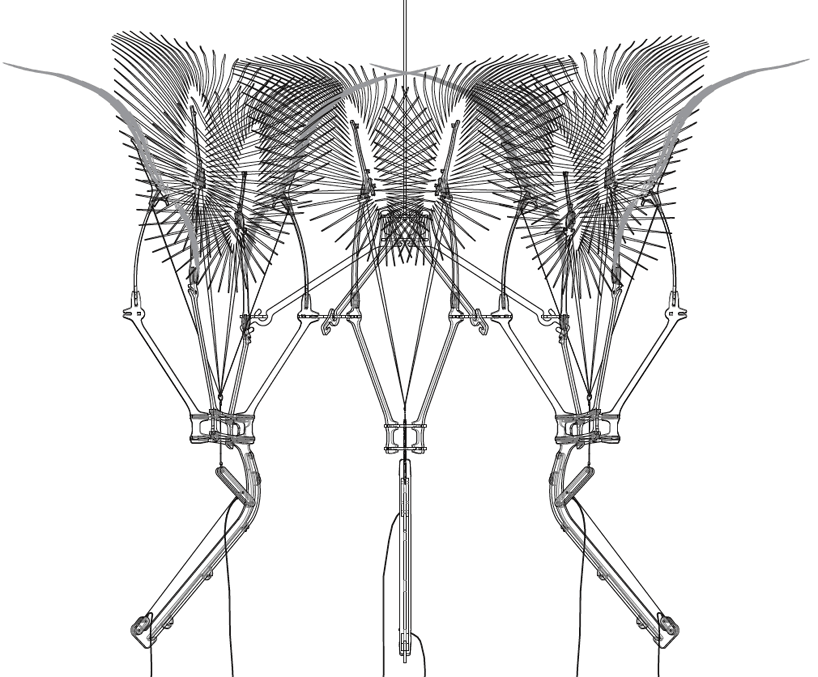 filter cluster elevation
filter cluster elevation
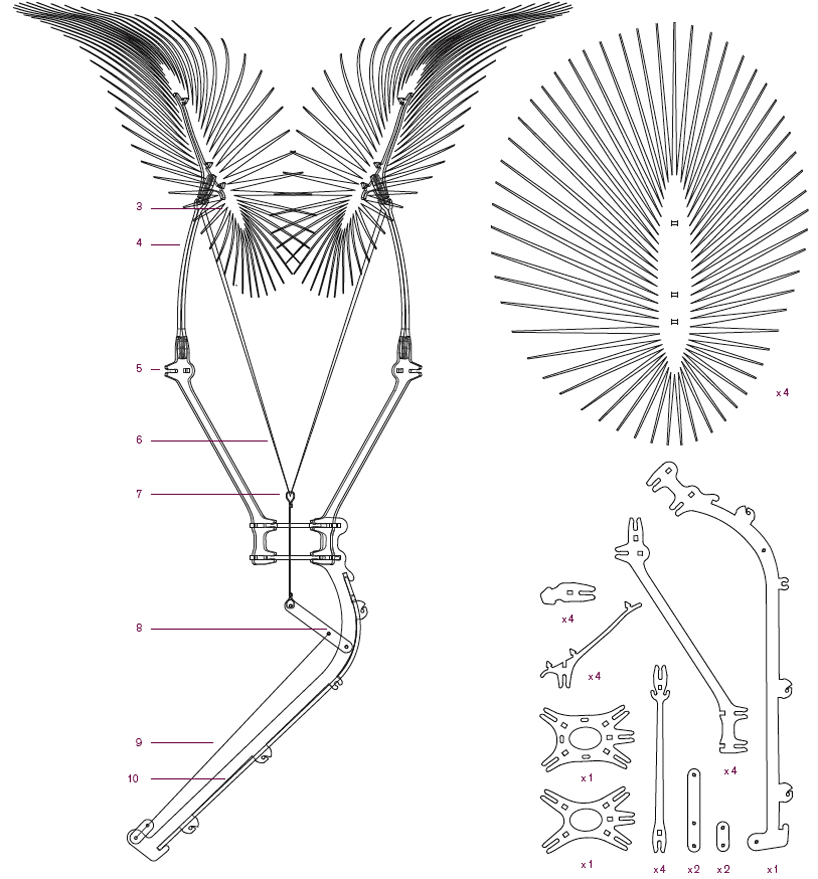 filter layer assembly diagram (3) filter feather (4) leaf spring (5) connection to adjacent filters (6) tension cable (7) tension hook (8) lever arm (9) shape memory alloy (SMA) actuator (10) sled assembly
filter layer assembly diagram (3) filter feather (4) leaf spring (5) connection to adjacent filters (6) tension cable (7) tension hook (8) lever arm (9) shape memory alloy (SMA) actuator (10) sled assembly
 skeleton typical configurations
skeleton typical configurations
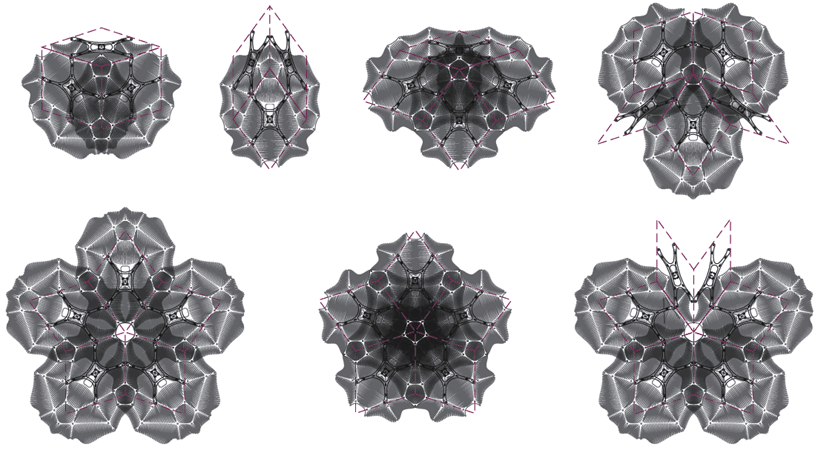 feather typical configurations
feather typical configurations


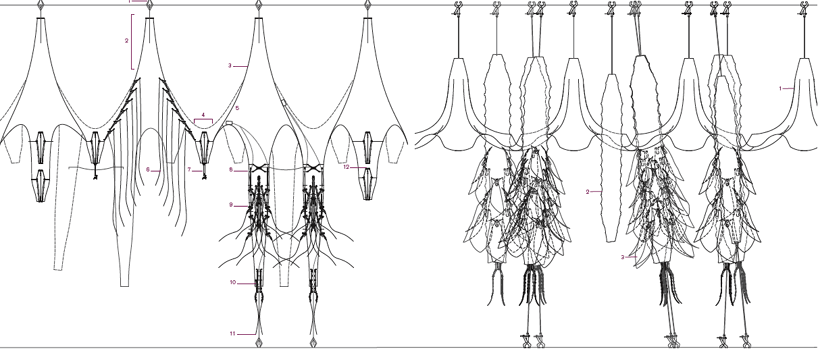 (left) hylozoic section – first generation (right) hylozoic section – second generation
(left) hylozoic section – first generation (right) hylozoic section – second generation
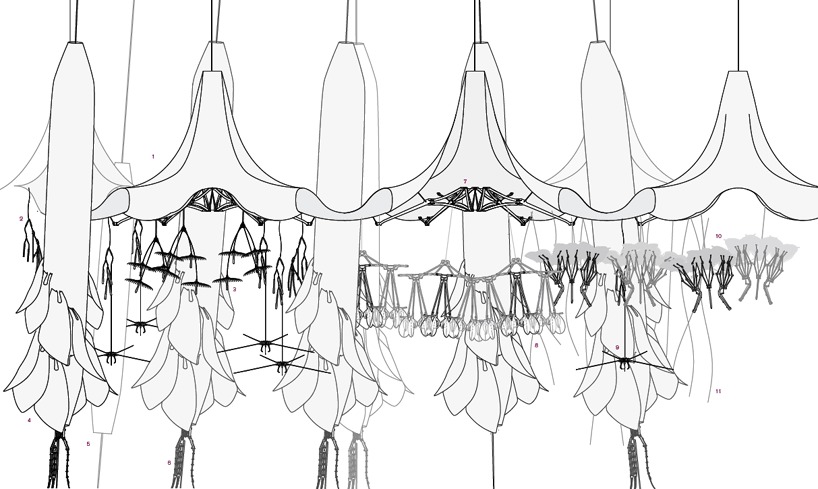 detailed hylozoic section (1) lily canopy element (2) anemone weed (3) hylozoic burrs (4) breathing pore column (5) swallowing column (6) sensor lash assembly (7) umbrella structural unit (8) cricket cluster (9) clamping needle assembly (10) filter cluster (11) whisker assembly
detailed hylozoic section (1) lily canopy element (2) anemone weed (3) hylozoic burrs (4) breathing pore column (5) swallowing column (6) sensor lash assembly (7) umbrella structural unit (8) cricket cluster (9) clamping needle assembly (10) filter cluster (11) whisker assembly
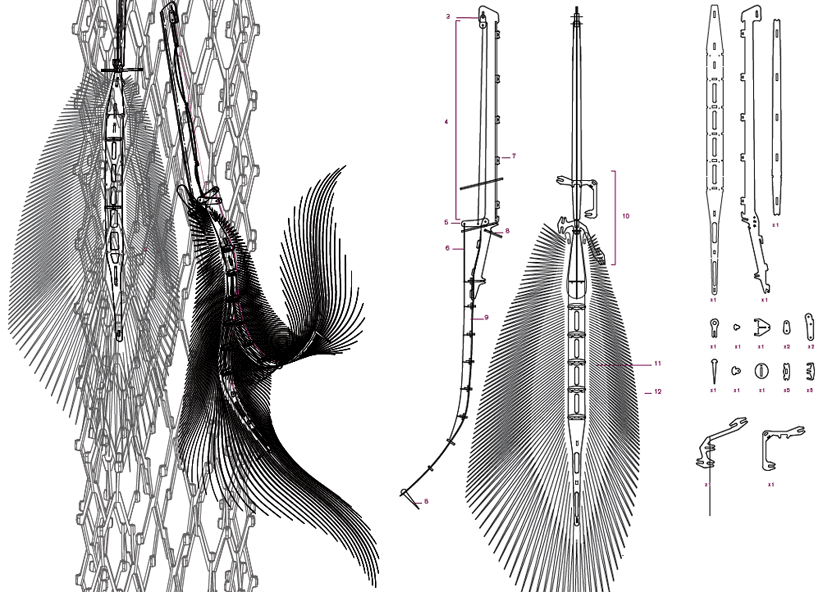 breathing pore assembly diagram (1) breathing pore assembly actuated position (2) breathing pore assembly rest position (3) adjustable SMA clip (4) SMA (5) lever (6) tensioned tendon (7) strengthening gusset for main spine (8) gland clip (9) copolyster tongue (10) tongue clip (11) arm units for attachment to mesh (12) tongue struts (13) feather
breathing pore assembly diagram (1) breathing pore assembly actuated position (2) breathing pore assembly rest position (3) adjustable SMA clip (4) SMA (5) lever (6) tensioned tendon (7) strengthening gusset for main spine (8) gland clip (9) copolyster tongue (10) tongue clip (11) arm units for attachment to mesh (12) tongue struts (13) feather
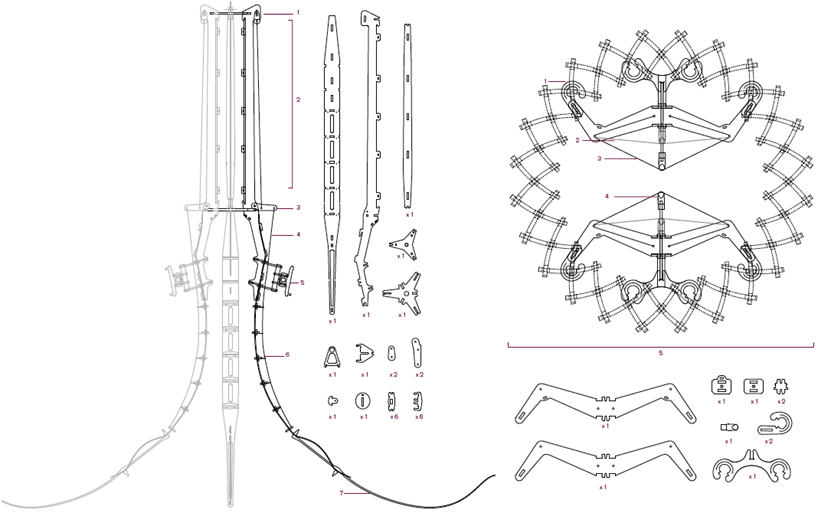 (left) senso lash assembly diagram (right) swallowing actuator assembly diagram – second generation
(left) senso lash assembly diagram (right) swallowing actuator assembly diagram – second generation
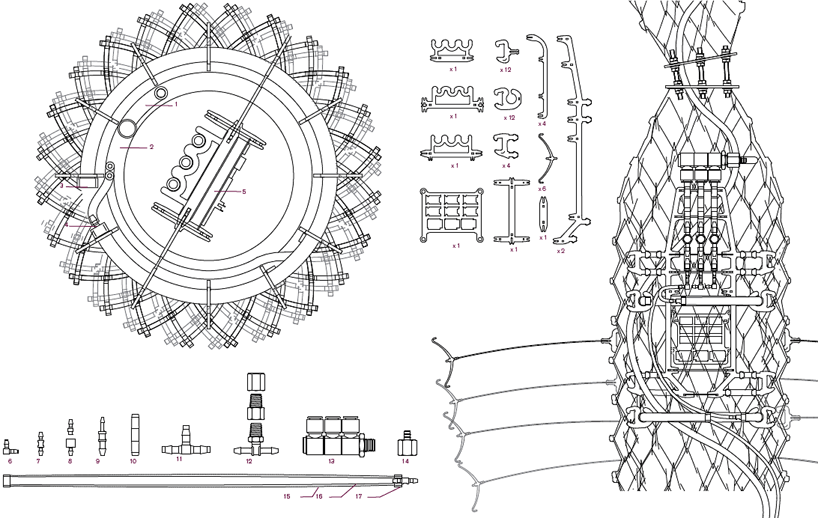 swallowing actuator assembly diagram – third generation (1) main air supply (2) main electrical harness (3) air muscle (4) local air supply (5) arduino/SMA valve mount (6) 1/8” elbow (7) 1/8” coupler (8) detachable coupler (9) 1/4” to 1/8” reducer (10) SMA valve (11) 1/4” tee (12) flow reducer/diffuser assembly (13) 3-way mainfold (14) threaded adapter (15) braided polyster sleeve (16) latex bladder (17) metal hose crimp
swallowing actuator assembly diagram – third generation (1) main air supply (2) main electrical harness (3) air muscle (4) local air supply (5) arduino/SMA valve mount (6) 1/8” elbow (7) 1/8” coupler (8) detachable coupler (9) 1/4” to 1/8” reducer (10) SMA valve (11) 1/4” tee (12) flow reducer/diffuser assembly (13) 3-way mainfold (14) threaded adapter (15) braided polyster sleeve (16) latex bladder (17) metal hose crimp
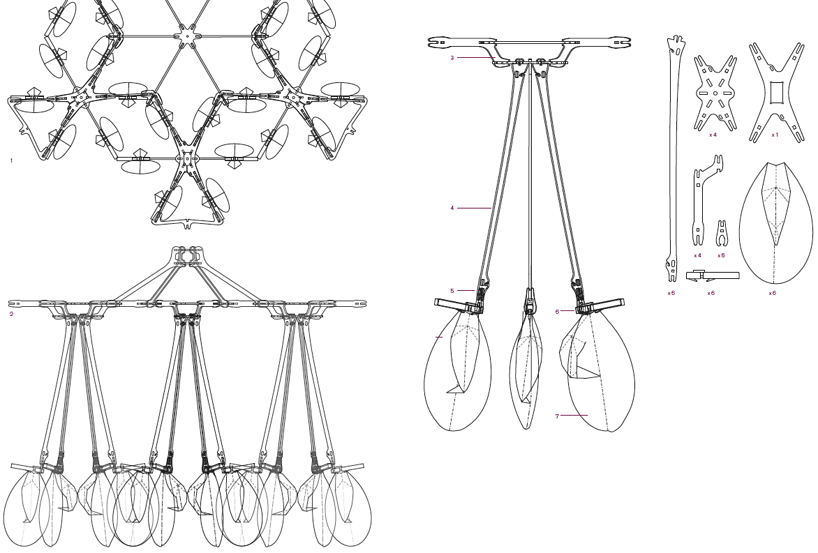 cricket layer assembly diagram (1) cricket cluster plan (2) cricket cluster elevation (3) cricket rhomb (4) stalk (5) actuator mount (6) shape memory alloy (SMA) actuator (7) cricket resonator
cricket layer assembly diagram (1) cricket cluster plan (2) cricket cluster elevation (3) cricket rhomb (4) stalk (5) actuator mount (6) shape memory alloy (SMA) actuator (7) cricket resonator
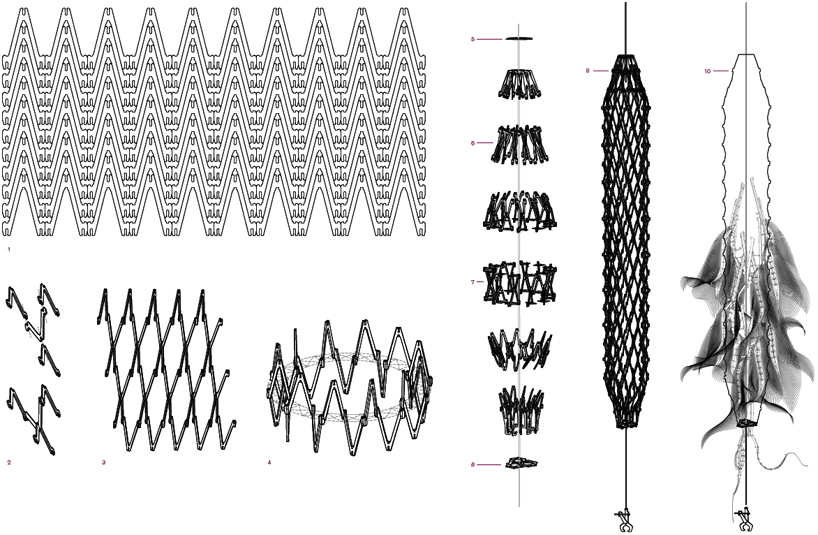 chevron assembly diagrams (1) chevron cutsheet tessellation (2) snap-fit assembly (3) basic mesh assembly (4) column mesh assembly (5) column cap plate (6) transition column taper (7) basic mesh assembly (8) kissing pore base plate (9) column assembly (10) breathing column assembly
chevron assembly diagrams (1) chevron cutsheet tessellation (2) snap-fit assembly (3) basic mesh assembly (4) column mesh assembly (5) column cap plate (6) transition column taper (7) basic mesh assembly (8) kissing pore base plate (9) column assembly (10) breathing column assembly
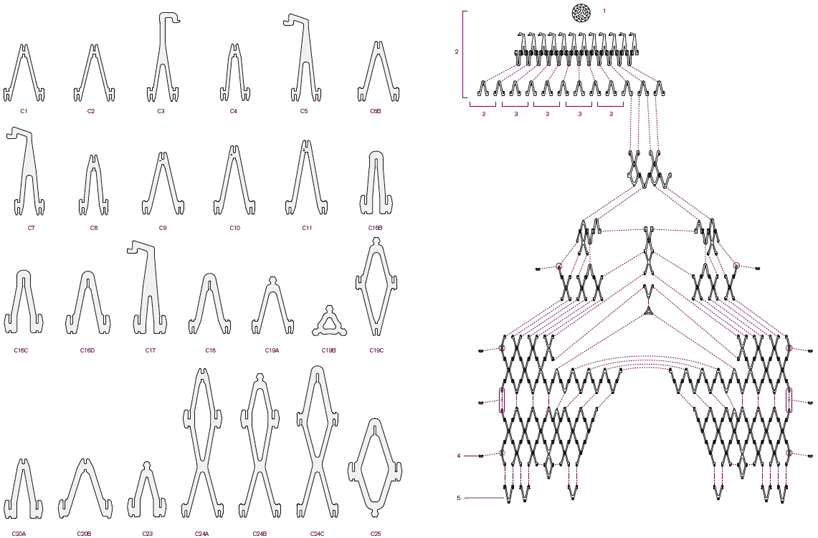 petal assembly diagram (1) lily cap hanging plate (2) lily cap assembly (3) lily petal attachment point (4) silicon petal attachment point (5) adjacent canopy attachment point
petal assembly diagram (1) lily cap hanging plate (2) lily cap assembly (3) lily petal attachment point (4) silicon petal attachment point (5) adjacent canopy attachment point
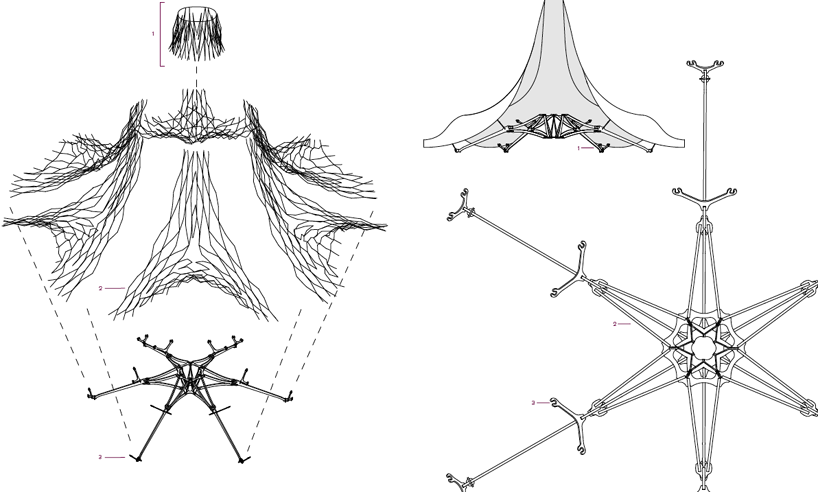 (left) lily canopy assembly diagram (1) lily cap assembly (2) lily petal (assembled) (3) ily umbrella assembly
(left) lily canopy assembly diagram (1) lily cap assembly (2) lily petal (assembled) (3) ily umbrella assembly
(right) lily umbrella assembly diagram (1) filter assembly attachment point (2) bifurcation members (3) connection to main lily canopy (4) main umbrella spine elements (5) lily canopy assembly (6) junction plate assembly
additional credits and acknowledgement: coordinator and supporter: canada council for the arts, the royal architectural institute of canada supporter and collaborators: natural sciences and engineering research council of canada, the social sciences and humanities research council of canada, MITACS accelerate, the ontario arts council, university of waterloo, university college london, syddansk universitet media sponsorship: azure magazine
Save
Save



